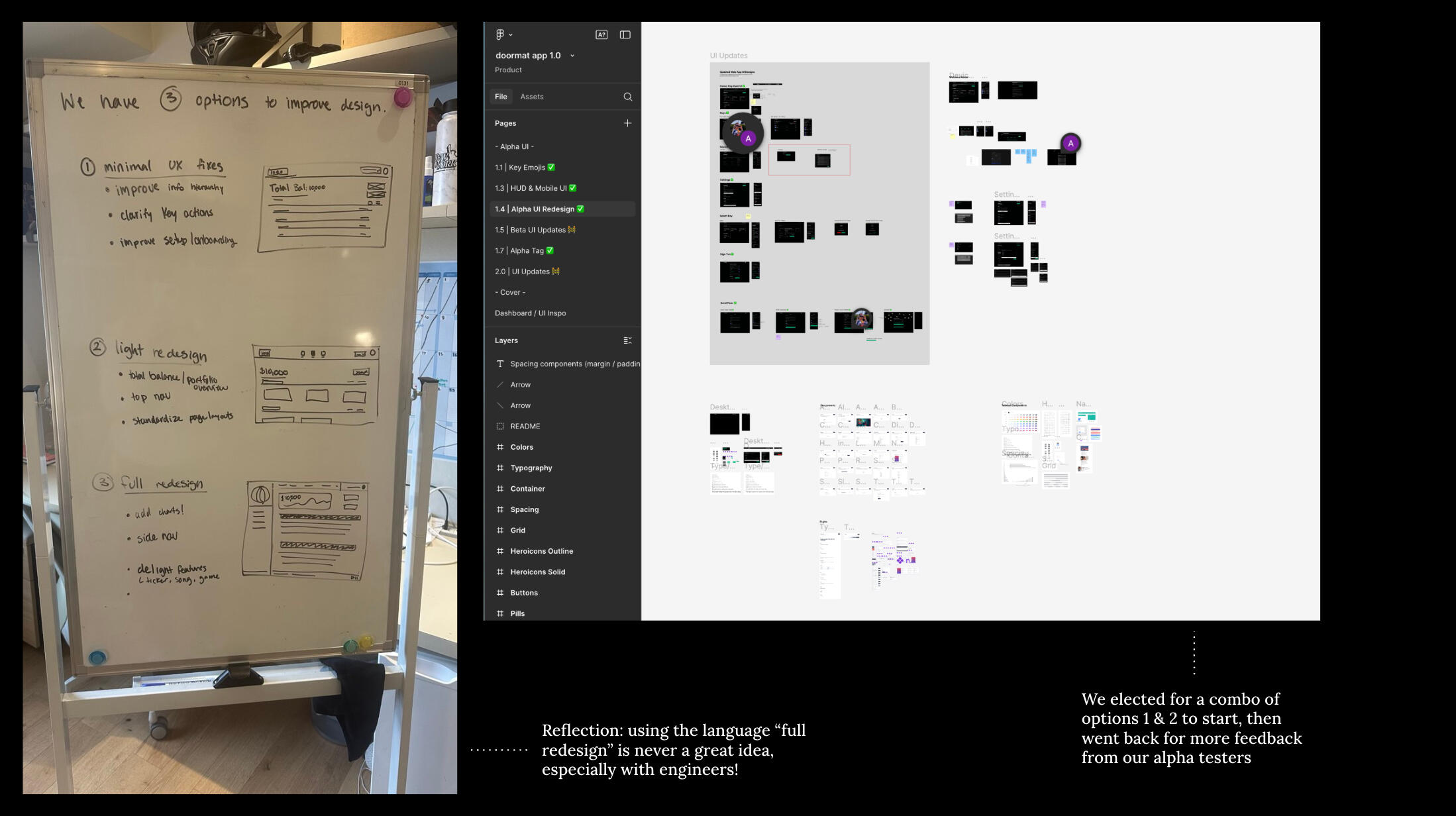Hi I'm Katy, I translate complex technology into clear stories that drive growth: from product design to GTM strategy to launch narratives. Previously I co-founded several companies, communities, and podcasts.Offline you can find me at the pottery studio or chatting with interesting folks for my podcast mini-series Reply Girls.
My first taste of startup life was during a study abroad semester in Australia, I stumbled into the university’s startup incubator, where graduate research was being turned into real products. I ended up leading design for an aged care hardware project, Conpago. There I learned how to move from idea to prototype, test go-to-market strategies, sell to businesses, and talk to users.Since, I've become the co-founder of 3 very different companies ranging from healthcare to social to finance. What drives me is a deep curiosity and the privilege of shaping how people first experience new technology.

COMPANIES FOUNDED
SIDE PROJECTS
| Reply Girls | 2024 - Now | Pods, Youtube |
| The Vice Index | failed experiment | Spotify |
| Cookbook | ETH NY 2023 | Github |
| Fitcheck iMessage App | Variant Founder Fellowship | App Store |
| Common Wallet | Climate Hack x Sozu Haus | Website |
| Port Protocol | ETH CC 2022 | Devpost |
| Seam v1 | Miami Hack Week 2022 | Devpost |
| FWB: Friend of the Week | 2020 - 2022 | Archived |
| Moss & Friends Podcast | 2020 - 2021 | Spotify |
Doormat: The Crypto Terminal for Advanced Users
How might we use MPC key management to help traders win more?

TEAM
Role: Product Designer
+ Trevor (CTO)
+ Abe (Engineer)
+ Elliot (User Researcher)
TIMELINE
May 2024 - Aug 2024
Two design sprints ahead of the alpha launch.
SKILLS & TOOLS
+ Figma
+ Midjourney
+ v0
+ User Research
+ UX Architecture
+ Visual Design
CHALLENGE & STRATEGY
Doormat was a powerful multi-key crypto wallet—but early users found it disorienting. Key actions were buried, onboarding lacked context, and users struggled to explain what the product actually did. Despite receiving $50 in demo funds, fewer than 10% returned after setup.My goal was to clarify the experience without diluting its advanced functionality. We ran seven alpha walkthroughs, implemented Mixpanel, and used insights to map three strategic paths forward: quick UX fixes, a light redesign, or a full overhaul. We began with light-weight changes that could be layered and scaled, allowing us to move fast while earning space for more structural redesigns.
How might we create dashboard to manage ten or more keys that feels powerful and intuitive?
BEFORE

AFTER
IA, DESIGN PRINCIPLES & LAYOUT
The redesign centered on three mental anchors: Accounts (what you own), Keys (what devices have access), and Actions (what you can do). We introduced a structured tri-pane layout—navigation on the left, a contextual workspace in the center, and an action panel on the right.Design principles guided every decision: expose power without clutter, prioritize orientation over explanation, and make user state transitions clear. We applied these principles through simplified flows, visual anchors, and a component system built for scale.

PRODUCT STRATEGY
Using the Kano Model, I scoped three paths: minimal fixes, a light redesign, or a full overhaul toward a Minimum Delightful Product. We started with the first two, balancing speed and clarity. Framing changes in layers (instead of as a “redesign”) helped maintain engineering trust while giving design space to evolve.
CONCEPTING
We explored three layout directions: token-first, key-first, and workflow-based, and ultimately chose a hybrid. A new badge and pill system made wallet types, permissions, and statuses legible at a glance.Every prototype was pressure-tested with alpha users. We tracked feedback in structured sessions, addressed friction points weekly, and layered improvements across onboarding, key import flows, and action visibility. Reducing confusion became a metric: every week, 10% clearer.

INTERACTION DESIGN
We rebuilt flows for importing keys, managing sessions, and executing key-based actions like signing and sending. Skeleton states, simplified confirmation patterns, and consistent interaction zones helped reduce perceived risk and increase predictability.By the end of the sprint, all users could name the product’s core actions unprompted. Retention jumped from under 10% to over 50%. The new system became the foundation for permissioning, team-based access, and policy logic.
LEARNINGS
The real fix wasn’t more onboarding—it was better layout. Crypto-native users don’t need ease, they need confidence. Clear architecture and visual logic built trust faster than any tooltip.Internally, framing the project in layers rather than as a full redesign allowed us to move quickly and collaboratively. The result was a product that felt as powerful as it was usable—and a process that left space for deeper innovation.
Seam × Pixels: Bringing Social Profiles into Gameplay
Created a custom integration to bring Seam social profiles in-game, letting users showcase their crypto identity inside Pixels.

TEAM
Katy (Design & GTM)
Andrew (Developer)
Nick (Seam CTO)
Luke (Pixels CEO)
TIMELINE
Two-week sprintMay 2023
SKILLS & TOOLS
+ Product strategy
+ Integration design
+ Figma
+ User research
CHALLENGE & APPROACH
Pixels is a top MMO onchain farming game with over 250,000 weekly players—but players had no visibility into who they were playing with. Our insight: social context was missing, and Seam could fill that gap.We launched a two-week GTM experiment to embed Seam profiles into Pixels, giving users a persistent in-game identity layer. Players could customize profiles using their onchain data—NFTs, music, GIFs, and more—without interrupting core gameplay.

Research, Insights & Constraints
We scoped engineering quickly, brought in a contractor, and interviewed Pixels power users via Discord. The audit showed users wanted social layers, but not at the expense of gameplay.
Key insight: players wanted a 50/50 blend of utility and self-expression. Timing the launch alongside a major Pixels update amplified reach. Constraints included limited time, no backend support from Pixels, and the need to preserve visual consistency with the game.
Design Strategy & Execution
The UX needed to be fast, expressive, and minimally invasive. We aligned on a profile panel that appeared in the sidebar, pulled data from users’ onchain activity, and let them customize with Seam’s modular components.We designed for two use cases: players who wanted to flex their social graph (POAPs, lens posts, music) and players who wanted to look up others’ profiles while playing. I led design, wrote product copy, and shipped the integration in under two weeks.
Outcomes
The launch 10x’d Seam’s active users in the first week. Around 5% of Pixels’ user base (~2,000 players) created Seam profiles, and the feature became a sticky social layer inside the game. Distribution was amplified by Pixels' own marketing and community events
🧲 Outcome One
Andrew (Developer)
Nick (Seam CTO)
Luke (Pixels CEO)
🧲 Outcome Two
Two-week sprintMay 2023
🧲 Outcome Three
+ Integration design
+ Figma
+ User research
REFLECTION
This project proved that distribution is design. Seam succeeded not just by embedding itself into gameplay, but by respecting its pacing and aesthetic. The result was a feature that didn’t just add identity—it made the world feel more alive.
WRITING
Writing has historically been my least favorite medium, but recently I've found myself surrounded by brilliant writers who have inspired me to figure it out. If you're wondering what my favorite medium is, I really enjoy hosting 1:1 conversations with interesting people (eg 1, 2, 3).
JUNE 2025
Designing Friction into Digital Experiences
The case for adding friction — clarity, trust, and better choices.
Pick a flower to receive a fortune...






